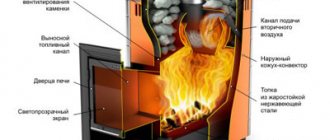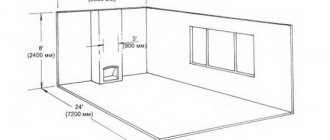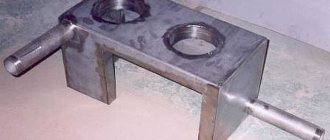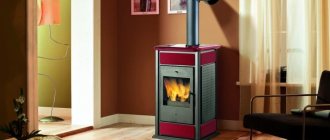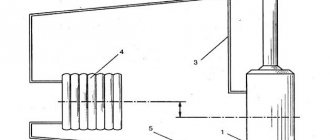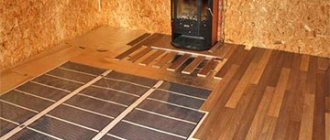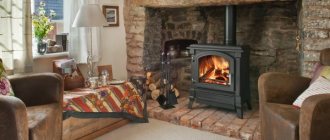05/08/2017 13006 Pechnik (Moscow) Many owners of private houses want to place a heating installation in their apartments. Such a hearth allows you not only to make the atmosphere as cozy and comfortable as possible, but also to acquire a source that brings warmth.
Another question that arises in this case is what is better: a stove or a fireplace? It is impossible to find a definite answer to this question, since both units have their own exceptional features and advantages. However, it is possible to make a choice. To do this, we suggest that you familiarize yourself with the materials in this article and view photos of ready-made installations.
Aesthetics and safety of use
Before buying a fireplace stove, it is important to familiarize yourself with the aesthetic qualities and features of each variation, because there is nothing better than a traditional brick stove. A brick stove is the classic and most popular option, which will certainly become the part and center of any living room and interior, thanks to its brick surface, tile, stone, and mosaic cladding.
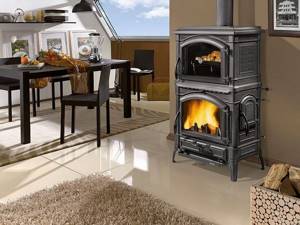
A brick fireplace stove will allow you to enjoy an elegant stone vault, with an open firebox in which a real bright and unbridled flame burns and dances. When choosing a fireplace stove for your dacha and giving preference to a brick stove, you should know that such a heating unit is only suitable for a classic interior and will not fit into a modern one. For safety reasons, such a fireplace stove for the home is also often supplemented with a sealed door with glass on a fire-resistant basis, through which the flame, although insignificant, to a certain extent loses some of its mystery and attractiveness.
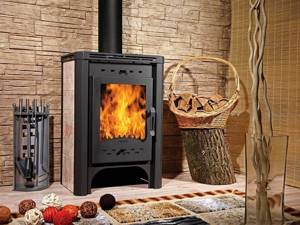
A wood-burning fireplace must fully comply with all standards and requirements for safe placement and installation in the house, since wood during combustion, unlike gas, has ways to emit creosote and accumulate it in large quantities in the chimney pipe, which is very dangerous for human life and health .

A cast iron fireplace stove, just like a steel one bought in a store in Moscow or at your place of residence, will be safer to install and further operate, since each fireplace from trusted manufacturers is initially manufactured according to existing quality and safety standards and is certified.
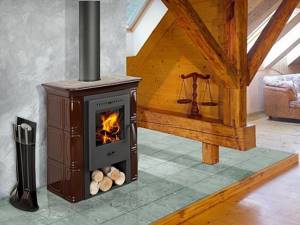
A fireplace stove, the price of which is determined by functionality and brand, although it has a closed hearth, it is completely sealed, which gives one hundred percent confidence that combustion and decay products hazardous to health will not penetrate into the room and will be strictly removed through the chimney.
A stove, the heating of which will allow you to heat a house with a given area, can become a source of sparks and a fire in the room due to the completely open fireplace insert. If you want to solve this problem and protect yourself, you can install a door or screen, but it is best to initially buy an oven that will be completely sealed and closed. A fireplace whose firebox is initially equipped with a door or damper will allow you in the future not to put a lot of effort into installing them in a brick oven.

The fireplace, since it is traditionally completely open, can not only cause a fire in the house, but also a direct danger to your children and animals, who, even if they touch the surface, can receive a serious and severe burn. A long-burning fireplace stove with a closed firebox is safer and is therefore recommended for installation in a house where there are children and pets, however, this does not exclude the possibility of getting burned on the door or heating elements, but access to the fire will be completely blocked.
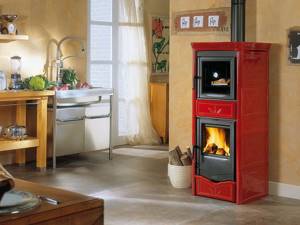
ADVANTAGES AND ADVANTAGES OF METAL OVEN.
They are not afraid of temperature changes and long breaks in the furnace, and do not require acceleration fires after downtime. That is, for those who come to a country house only for the weekend during the cold season, this is the best option. Moreover, such ovens heat the air very quickly.
Another advantage is the relatively low cost (when compared with a brick oven). Again, to install such a “hot heart of the house” you do not need to make a foundation or hire a stove-maker.
Compact dimensions allow you to place the metal stove almost anywhere. But observe the fire safety clearances, this is very important (the exact distances are indicated in the installation instructions). However, if the room is extremely compact, the indentations are sometimes reduced. And fire safety is ensured with the help of protective screens. The walls are fenced off with steel sheets, but not tightly, but with a 2-3-centimeter air gap. There is also a gap of 3-4 cm between the edge of the sheet and the floor. Thus, the metal, when heated, increases the convective movement of air near the wall. This protects the wall from overheating.
Last but not least, a factory-made metal stove may have a fire safety certificate. This means that it is much easier to obtain permission from firefighters to use it (provided that the installation was carried out exactly according to the instructions).
Functionality and design
Wood, used for lighting stoves and fireplaces, is one of the most inexpensive materials, which will allow you to save more than when using electricity, gas, coal or pellets. Moreover, if we talk about heating, the efficiency of solid fuel units is very low and amounts to no more than 12-16 percent; almost all the heat evaporates into the street through the chimney at lightning speed.
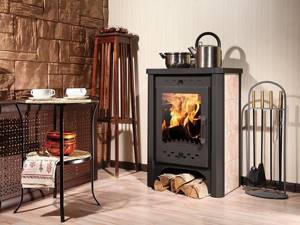
At the same time, more productive heating and economical fuel consumption can be achieved by placing only 1/3 of the required amount of firewood in the fuel compartment. It should also be noted that closed type stoves with a door are more efficient and heat the house, unlike completely open fireplaces, which suggests that the stoves are more efficient in terms of heating.
Another important criterion for choosing between a stove and a fireplace is such an item as environmental friendliness. If we talk about wood, then during its combustion in the hearth, a large amount of carbon dioxide is not released, in any case, no more than in a forested area, in the case when the wood decomposes naturally. Closed-type stoves, with their heating efficiency, are the most environmentally friendly and economical, they can be used as a main or additional source of heating, depending on the power and functionality of the equipment you have installed.
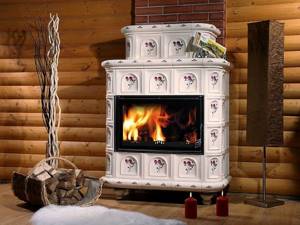
A fireplace, for which brick is the main manufacturing material, is a fairly high-quality and heat-resistant material, while the fireplaces themselves can be either completely open or closed. An open fireplace should never be left unattended, as an open fire can cause sparks to enter the room and cause a fire. Before you buy fireplace stoves in the Moscow region, you need to become more familiar with the nuances of open fireplaces:
- Open fireplaces are extremely uneconomical in terms of fuel consumption, since due to the complete absence of a door or damper, you cannot control the level and intensity of fire burning in the hearth, or the amount of incoming oxygen;
- Brick fireplaces, despite their good storage capacity, take a long time to warm up and only after that they begin to release heat into the room;
- Since the fireplace insert is constantly open and is not equipped with special dampers, if necessary, you will not be able to stop the heating of the room, and the house can become very hot.
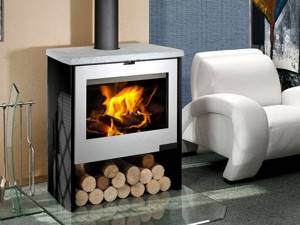
A closed fireplace with a sealed door is safer; there is also no need to constantly monitor the flame, and all thermal energy is spent as rationally as possible and does not escape through the chimney. Long-burning fireplaces that can operate in economical mode and serve as the main source of heating are popular. Closed fireplaces are the most efficient, safe and practical; they consume fuel gradually by adjusting the supply level and amount of oxygen using a damper.
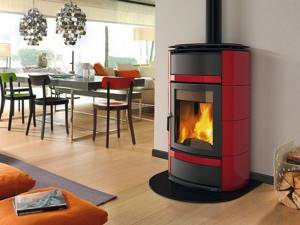
History of the stove-bench
In Russia, fireplaces, like many other things from Western culture, appeared thanks to the efforts of Tsar-Emperor Peter I. At first they began to be installed in boyar houses, then the nobility adopted the fashion. In any case, a fireplace in Rus' has always been an indicator of the social level and property wealth of the owner.
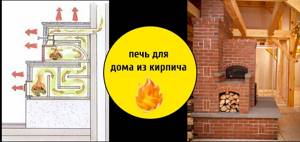
Traditional stove for a red brick home
A stove was much more common and rational for large log houses in Rus'. A large Russian stove was installed in the middle of the room and was the starting point for the rest of the home's layout. It warmed the whole house well in severe frosts, giving off heat for a long time. They steamed, boiled, fried and simmered in a Russian oven. “Old and young” slept on it.
Today, the traditional Russian stove is leaving modern Russian culture. Probably, there really is no longer any need for it. They have been replaced by devices that are less complex in design, more compact, and take up little space. But a real stove retains its main feature - the presence of a multi-well chimney (smoke channels) passing through the interior wall. Thanks to this and other design features of the furnace, the heat transfer efficiency is 50% or higher.
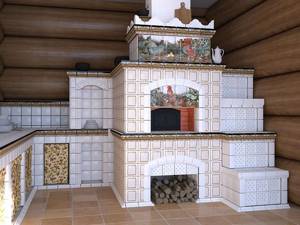
Russian traditional stove lined with ceramic tiles with a pattern
A cast iron stove with removable “pancakes” makes it possible to cook any food on the stove, adjusting the cooking intensity. Among other things, a brick oven “breathes” (a stone oven does not). When heated, its brick body releases moisture into the surrounding space, and when cooled, it absorbs its excess. Thus, the humidity in the room is maintained at the necessary “dew point” level that is useful for normal well-being.
Installation and combined stoves and fireplaces
After purchasing a stove or fireplace, it is important to choose the right place in the house and the interior of the room; if you take into account such techniques as Feng Shui, the fireplace is best placed in the living room. At the same time, the firebox and chimney should always be cleaned of soot, soot and ash, and fuel is stored in the hearth even during idle times.
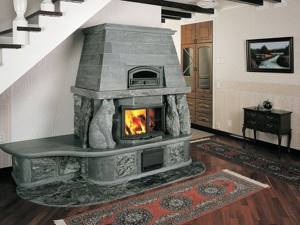
You should not install an open fireplace in the center of the room, as this location is not safe, you will have to isolate more space, and you will not be able to place furniture, textiles and other flammable items close to the fireplace.
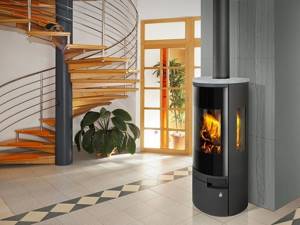
The optimal place to install a stove or fireplace is along the wall, while it is best to install it on the south side, so the heating will be more directed and intense. A mirror above the fireplace or flowers on the sides will complement the existing image, enhance the magic of fire, make it brighter and more voluminous.
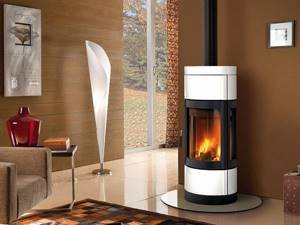
In addition to stoves and fireplaces, there is a so-called hybrid modification, otherwise called a fireplace stove, which advantageously combines a number of advantages and design features of both heating units.
The corner fireplace stove, just like the straight one, has a sealed closed firebox with a glass door, and due to the presence of smoke circulation channels, heating becomes many times faster and more efficient. The advantages of fireplace stoves include a large and spacious combustion chamber, which allows the unit to operate from one load of firewood for up to 10 hours and heat an area of up to 90 square meters.
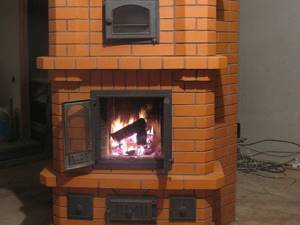
The fireplace stove can operate in one of certain modes:
- According to the principle of an open fireplace, when the flows of generated gases spread across the ceiling without warming up the portal of the heating structure itself;
- Also, the gas formed during the combustion of wood can spread through the smoke circulation channels and exit through them into the room itself.
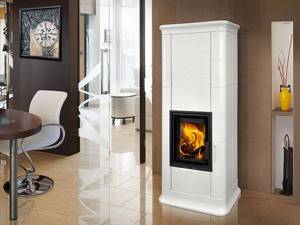
A fireplace stove with a stove, in addition to its heating function, allows you to cook food; the heat generated in the combustion chamber is consumed and used for cooking, which is economical and profitable.
Any fireplace and stove consists of a firebox, which is connected to the chimney through a stainless steel wall pipe; the base of the hood is a condensate collector, complete with an inspection hole and connection point.
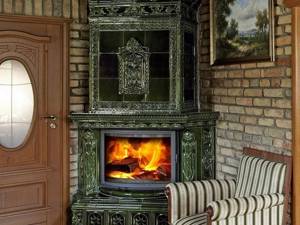
The very first stoves were equipped with such an element as a grub, but today it is not used, and in order for the products of combustion and decay to go outside, fireplaces and stoves are equipped with a pipe and a boiler, as well as an exhaust mechanism.
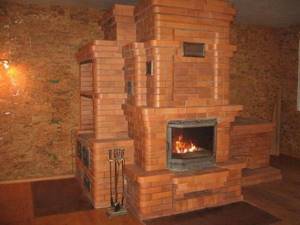
After the fuel is placed in the hearth, the fireplace stove begins to warm up and releases heat into the room; not only the portal heats up, but also the door.
Installation of combustion chambers, including ready-made ones, is carried out only according to instructions and by experienced specialists, and the construction of a brick stove is carried out in order and only by a qualified stove maker.

So what should you choose: stove or fireplace? It all depends on your goals and individual preferences, if you want to install heating equipment to heat your home, give preference to a stove, but if the aesthetic component comes first for you, buy a fireplace.
After watching this video instruction, you will learn how to choose the right fireplace stove for your home or cottage and what you need to pay attention to:
So which should you prefer?
So, fireplace or stove? Both are good. But there are some peculiarities. So, if you prefer the option with an oven, then the possibilities for cooking a wide variety of dishes expand endlessly. In practice, a stove with a cast iron stove can replace the housewife with an electric stove or a gas stove, one of which will need to be provided if choosing the option with a fireplace. No, something (for example, shish kebab) can be cooked on the coals of a cooling fireplace, but the range of dishes will be much poorer.
Aesthetics and interior design. The bustle of the city is far away, there is almost virgin nature all around, silence, an armchair pulled up, the flames of an open fire playing; there is a blanket on my knees, tongs for turning firebrands in my hand; there is good whiskey in a glass on the table nearby - victory is clearly behind the fireplace.
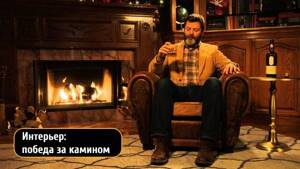
Heating the entire room for a long time. However, if the wind is howling outside the window and in the chimney, the glass of the windows on the inside is covered with ice, because the frost outside is thirty degrees, and if it’s Siberia, even more. I want to sleep, but with an extinguished fireplace the house will quickly freeze, so the stove will be in an advantageous position here.

But the stove will retain heat in its body until the morning and will little by little release it into the space of the room.
It's up to you to decide - while away the long chilly evenings by the stove or fireplace - which is better?
Total area of the house
So, the first parameter that must be taken into account when choosing is the total area of the building that needs to be heated. The larger the area, the greater the required power and thermal performance of the device. Let’s say, if you need to heat the entire building, then an ordinary fireplace or stove will not be enough; you need to choose a special functionality, which may consist of:
- Hot air distribution systems to adjacent rooms. It is a system of pipes and air ducts through which hot air from the heater enters the selected rooms.
- Systems that are used in fireplaces with a water circuit. It is a hydraulic circuit through which hot water circulates from the heater to other utilities - radiators, radiators, heated floors and even to the boiler. In addition to heating, this system can be used to organize domestic hot water.
Attention! An air and water heating system can be included in both types of heating devices under consideration.
If the house is large, with several floors, then in addition to the expanded functionality, you will most likely need not one, but several heating devices at once - one per floor. This solution will create a reliable, efficient and independent heating system for the entire building. Moreover, in this case you don’t even have to choose, but buy both products at the same time. But if the goal is to heat large spaces, then a fireplace is more suitable for this, since modern fireboxes that make up the design of such a fireplace provide the opportunity to select very high powers.

If the house is very small, then a heating stove is ideal for it. Firstly, it will not take up much space and will save useful living space. Secondly, the power of furnace equipment is well suited for small spaces. If there is a need to heat several rooms at once, you should choose the option with air ducts or a water circuit.
Choosing a chimney for stoves and fireplaces
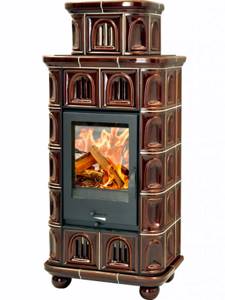
A stove with a ceramic finish, ENBRA Olimp, costs 2–3 times more than conventional steel models, but it looks more impressive and is also capable of accumulating heat and releasing it within 2–3 hours after the end of the fire.
You should be mentally prepared for the fact that the chimney will most likely cost more than the hearth. Of course, for a budget stove there is no need to buy expensive ceramic pipes - insulated steel sandwiches costing from 1800 to 4500 rubles are quite enough. for 1 linear m, depending on the diameter, steel grade and insulation thickness.
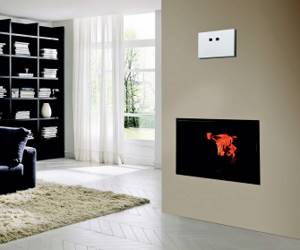
A firebox built into the wall will not be cheap, from 45 thousand rubles, but you can save on framing. All you need is fire-resistant drywall, steel profiles for the frame and ventilation grilles. Photo: EdilKamin
It is desirable that the smoke channel be made of stainless steel grades 308, 321 according to the AISI classification or their Russian analogues, and the thickness of its walls is at least 0.7 mm (alas, pipes with walls of 0.5 mm are more common). It is allowed to lay only the first 1–2 m of pipe without insulation; then it must be insulated with a layer of stone or ceramic wool at least 30 mm thick (optimally 40–50 mm). It is advisable to equip a long-burning furnace, during operation of which a lot of condensate is formed, with a chimney made of austenitic steels (AISI 430, 439), resistant to acids.
Methods for connecting the stove to the chimney
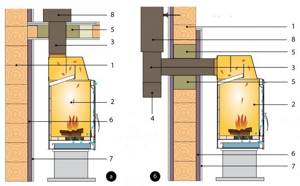
Attachment (to the top pipe) (a) Through a tee (to the rear pipe) (b). 1 - wooden wall; 2 - oven; 3 - single-circuit chimney; 4 - condensate collector; 5 - non-flammable thermal insulation (stone or ceramic wool); 6 — thermal insulating mat (ceramic wool + asbestos cardboard); 7 - gypsum fiber sheet; 8 - insulated double-circuit chimney
- Security and home automation
Choosing a fire extinguisher for your dacha: 5 important questions to answer before purchasing
For what purposes do we choose a heating device?
The main difference between stoves and fireplaces dictates the choice of their scope of application. Since the devices are, one way or another, designed for heating, when choosing, you need to decide how often you want to use the structure.
Heating stoves are designed for long and constant burning. Such devices can be used not only as an additional, but also as the main source of heat. Long-burning and high-power stoves are available for sale. They provide many hours of operation of the device from one load. Such models are best suited for installation in permanent residences. For periodic use in dachas, country houses and private houses, you can choose stoves without a long-burning function
Most heating stoves are highly efficient devices that provide fuel efficiency (efficiency) up to 70 - 80%
Fireplaces are mainly chosen for occasional use. Most models are not designed to heat efficiently. Therefore, fireplaces will be an excellent addition to housing with an existing heating system. They are chosen for a country house or cottage with periodic visits. It’s always a pleasure to spend an evening near such a device.
Pros and cons of boiler heating
Boiler devices offer more opportunities, compared to stove devices, for organizing full-fledged heat and hot water generation systems in automatic mode. But greater opportunities also bring with them greater challenges. Let's list the main advantages and disadvantages.
Pros:
- heating large houses with several floors with one unit
- heating all rooms at once in any quantity
- greater power and performance
- Any type of energy source can be used
- You can use several types of fuel at once on the basis of one device
- high level of thermal power
- equipped with modern options
- automatic operation and process control
- no need to monitor the operation of the device on an ongoing basis
- minimal control over work
- rare fuel supply
- equipping with automatic protection systems
- in case of an electric boiler: no need to install a chimney
- in the case of combination boilers: energy savings
- high efficiency
- Possibility of installation in an already finished house
- you can change the energy source from one to another when replacing the burner
- it is possible to organize heating and hot water systems simultaneously
- versatility
- convenient operation
Now we list the disadvantages that are important to consider when choosing boiler installations.
Minuses:
- usually high cost of equipment
- high consumption of energy source with a large area of heated premises
- the need to design and install complex engineering networks
- possible freezing of utility networks during the cold season
- expensive maintenance
- the high cost of some energy resources
- complex installation
- possible breakdowns of complex automation
- the need to organize a boiler room or a separate place/room for equipment location
- the need to install a chimney (except for electrical installations)
- noisy operation of some models
Attention! Any boiler using combustible fuel (except electricity) requires the installation of a chimney duct to remove combustion products! The use of boiler systems without a chimney is strictly prohibited; it leads to a great risk of fire, damage to life, health and property.

